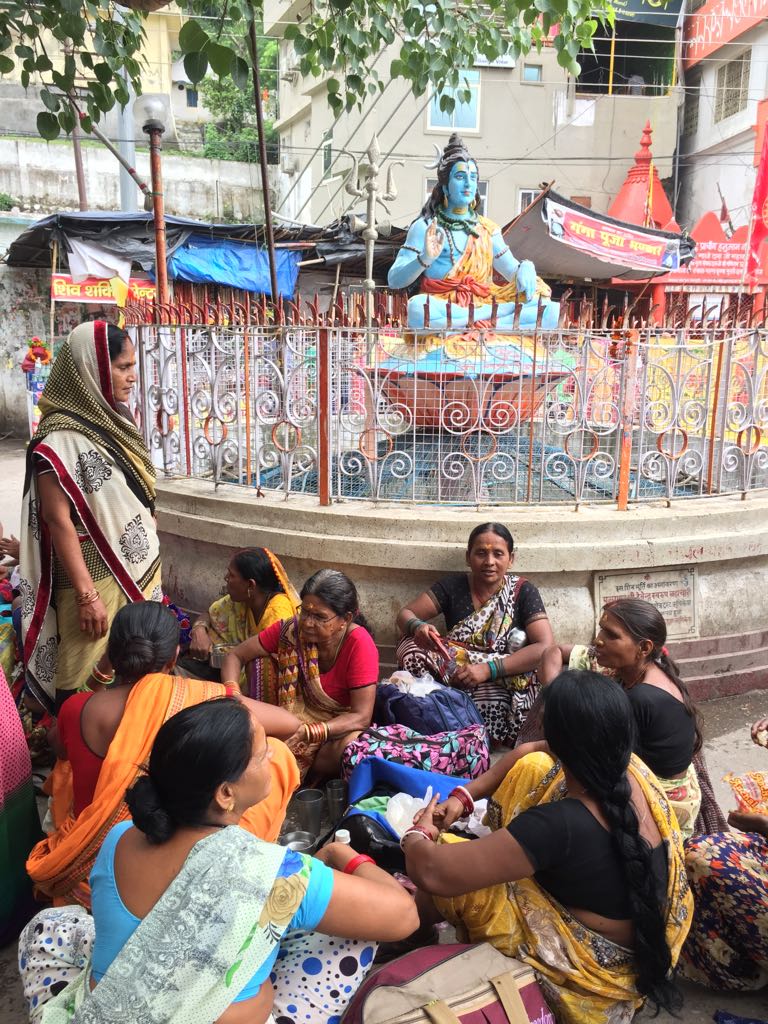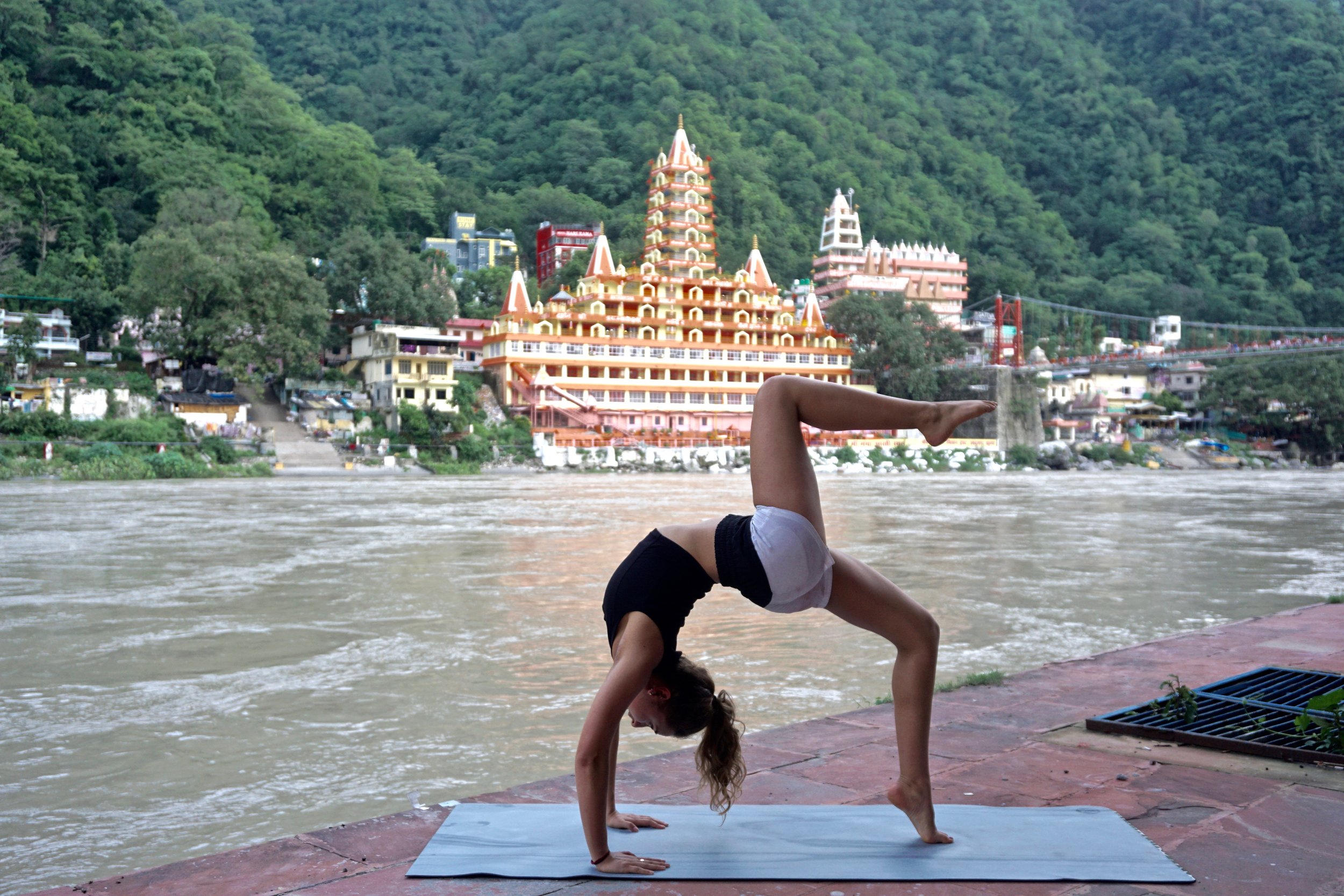Yoga Teacher Training in India
It’s wild to think that this time a week ago I was just finishing up my Yoga Teacher Training at Rishikesh Vinyasa Yoga School… I literally had no idea what to expect when I got there. In fact, I went in with no expectations at all, which, chapeau to me, was a bloody good way of going about it. Cuz in the end, the whole experience was nothing like what I could ever have imagined. The whole journey was a freakin sweaty-ass roller coasted of emotions, sore muscles, laughter and tears. My heart aches thinking back, because gawd-damn those were some of the happiest days of my life. I’ve tried to sum it up in this post, and I included an FAQ section at the bottom to answer some of the main questions I’ve received. If you have any other questions don’t hesitate to comment below or message me personally! I hope this helps some of you future yoga teachers and inspires the rest of you to think about possibly doing a YTT as well.
Daily schedule
6:00-6:30 – Herbal Tea
6:30-7:00 – Morning cleansing (Neti Pot)
7:00-8:30 – Vinyasa Class
8:30-9:30 – Breakfast
9:30-10:30 – Anatomy Class
12:00-1:00 – Lunch
2:00-3:00 – Philosophy Class
3:00-4:00 – Alignment Class
4:00-5:30 – Ashtanga Class
6:00-7:00 – Meditation Class
7:00-8:00 – Dinner
Yoga Classes
Our certification focused on vinyasa and ashtanga training. We had 3 yoga classes a day: vinyasa flow, alignment and ashtanga. So that totals 4 hours of yoga a day… yup no f-ing around over here. Not gonna lie it was pretty intense. After a few weeks of that, your body’s probably gonna start giving up on you. Pretty sure every single one of us had a minor injury at one point or another just from physical exhaustion. I will say however that pushing yourself to such an extent is really how you improve and I think all of us were shocked at how much progress we had made in such a short amount of time. The classes were mainly focused on the building up of our own strength and flexibility, which was amazing, however there was not a huge emphasis on learning actual teaching methods up until the last week. Our final test was to teach a vinyasa class to the rest of the group. It’s crazy how much you pick up without realizing. Even if we weren’t really taught how to teach, simply having attended so many classes throughout the month allowed us to feel so comfortable leading the class ourselves.
Theoretical Classes
In terms of theoretical classes we had anatomy, philosophy and meditation. Anatomy was probably my favourite class of the entire day. We went through each anatomical system of the body in detail as well as all of the important muscles and bones. Everything we learned was then always brought back to yoga. Our teacher explained which specific asanas would help strengthen this specific muscle or help that particular postural problem.
Philosophy was as you can imagine, less concrete, but also super interesting. The first weeks we had a teacher that none of us could understand and we really had no idea what the hell was going on. The class ended being more of a comedy club than a class.. but hilarious and so much fun. And in my opinion, laughing is never ever a waste of time. We later got a new teacher who explained everything really well and took in any of our wild questions along the way.
In meditation class we essentially tried out many different forms of meditation; from music mediation to walking meditation, dancing meditation to candle light meditation. My favourite being the one where we lied down on the floor in savasana and belted our lungs out to the catchiest Sanskrit songs you’ve ever heard in your life. In the end we could chose any form of mediation we pleased and taught a class ourselves.
Cleansing Rituals
Neti Pot
This is definitely the easiest one of all the rituals (almost pleasant even) although I have to say we were all pretty terrified on day one. Cleansing with a neti pot basically involves clearing your nasal passages by pouring saline water in one nostril until it flows out the other. This to me was the perfect introduction and set the stage for the whole experience by teaching me something valuable. The time I spent worrying about shoving a plastic teapot up my nose was 100% worse than the actual act. It just goes to show that there’s no point making a drama in your mind, in the end, sometimes it’s better to close your eyes and go in blindly. DISCLAIMER: this is definitely NOT always the case, if a strange man offers you to get in his van for free popcorn DO NOT PROCEED BLINDLY (:
Vaman Dhauti: Induced vomiting
At the end of our first week, we were encouraged to take part in Vaman Dhauti (“vaman” meaning middle and “dhauti” meaning cleaning, therefore “cleaning the middle”; digestive tract cleansing). If that sounds in the least bit pleasant, I can assure you right away that it is not. The basic jist is to drink about a gallon of salt water until you throw up…and then drink more water, spew again, and repeat. If you don’t find yourself spewing naturally, you have to stick your fingers down your throat and induce it. I know what you’re thinking: “where can I sign up?!” TBH I didn’t love it nor feel particularly “cleansed” afterwards, but I will say squatting outside with the whole group and engaging in communal vomiting was a bonding experience like no other. I definitely recommend this if you want to break the ice real quick with people you don’t know… activity idea when meeting the boyfriend’s parents for the first time perhaps?
Shank Prakshalana: Induced bowl movements
At the end of the 2nd week, we were encouraged to try another type of traditional Hindu cleansing, this time said to evacuate all impurities lingering in the small intestine and reboot the digestive system. In this cleansing, you drink 2 glasses of lemon salt water followed by a series of dynamic stretches and repeat. You have to do this over and over until you essentially shit yourself (excuse my language). You then do the whole process repeatedly until what’s coming out your bottom end is as clear as the water you’re drinking. This one didn’t go to well for me. After about glass 8 I really couldn’t stomach the water anymore and every glass I drank I ended up spewing back out. A few hours later when everyone had crapped themselves clean, I was still downstairs, feel sick AF, doing my freakin dynamic stretches by myself like an idiot, waiting for the runs to come…but they never did. Yet again I didn’t feel particularly “cleansed”, but definitely felt absolutely exhausted and drained for the rest of the day.
Food
Breakfast
We would have breakfast after vinyasa class at 8:30 every morning, and trust me after such a jam packed morning, we were always freakin staaarved. Initially breakfast was always fresh fruit (usually watermelon, papaya, mango or bananas) and an indian dish such as rice, beans or daal. I would serve myself a big bowl of the fruit and then have some rice cakes and peanut butter than I bought at a health food shop near by (I’m huge fan of daal and all… but given the choice first thing in the morning, I still pick that good ol’ PB). A few weeks in, the chef started making oatmeal, and we were all so happy with it, that we begged him to make it every day from then on. So after that, I had porridge with banana, peanut butter and protein powder (from home) every morning, which became very most probably the best part of the day.
Lunch
After a busy morning, we would sit down for lunch at 12:00. It changed every day but was always along the lines of daal, veggie curry or potatos with rice and chapati. Even though it was always pretty much the same, I honestly never got tired of it. After the first few days when I saw myself getting chubbier by the minute I decided to chill out on the rice and chapati and just filled up on veggies and beans.
Dinner
There was a big gap 7hr gap between lunch and dinner, so I would usually snack on a few almonds in the afternoon. Regardless, we were always starved when 7 o’clock rolled around (slash meditation class was usually spent thinking about food…). Similarly to lunch, it was usually veggie/potato curry and daal with rice or chapati.
Rishikesh
If you’re unsure where to do your YTT course, I could not recommend Rishikesh enough. Not only is it the world capital of yoga, but it’s also an amazingly beautiful little city; big enough to have lots to do and see, but small enough to know your way around easily after a month. The city is built on the Ganges making it an especially spiritual place for Hindus, which is definitely something you can feel. The city is super safe, and although I didn’t really walk around alone much, I would have felt completely comfortable doing so. There are lots of amazing healthy cafes and restaurants (check out: Little Buddha, Pure Soul, Ganga Beach Restaurant, Devraj German Bakery) which serve delicious Indian food but also fresh green juices, salads, Middle Eastern food, vegan cakes etc. The city is the perfect mix of rich culture and tradition while being very Westerner-friendly; everyone speaks english, you’re welcomed everywhere as a foreigner and I’ve never been scammed or ripped off. The city can get a little overwhelming though – Indians have the habit of honking ALL THE TIME even if the road is completely empty. I was really grateful that our school up a bit out of the city so we could have some peace and quiet.
FAQs
- What level do I have to be at to join a YTT program? I’d say all levels are welcome, however it’s true that it does get quite intense. I would recommend having done maybe a year of yoga recriationally before hand. We had one guy in the group who had only done 10 classes before coming, and he killed it. As long as you’re ready to push yourself, you’ll be fine! (just maybe make sure you know the basics AKA what is down-dog, before hand).
- It it only for girls?! Definitely not!! Yoga was traditionally only for men… yet somehow as it’s popularity exploded in the west, it’s been dubbed as a “girl thing”. For real, if you’d have a look at the insane shit our yoga teachers did in India (I’m talking legs behind the head and carrying the full load of your body with one hand) you would understand the amount of strength required to do it properly! In our group we had 2 dudes, and all of our instructors were male, so it’s definitely open to ladies and men alike
- How can I prepare for my YTT? Should I study before hand? Honestly, I didn’t prepare at all, and I really don’t think I missed out on anything. No matter what you read or study in preparation, chances are you’re going to relearn everything from a completely different perspective when you’re there. You’ll learn everything you need during the course, so I wouldn’t stress out about studying before hand (unless your school requires otherwise).
- How do you memorize all the Sanskrit names?! Once again, no need to stress out about it. Of course I can only say for sure about my school, but I highly doubt any school would actually expect you know every single asana name in Sanskrit. Although you’d be surprised at how much you actually pick up listening to the names being spoken in class. By the end I knew the major vinyasa postures in Sanskrit as well as most of the Ashtanga Primary Series. The girls and I came up with lots of little tricks to remember, for example: parsvottasana (intense side stretch pose) is the last posture of the standing sequence so you’re probs tired and thirst therefore “pass water” becomes “pars-votta”. Get it?!
- How did you chose your school/location? I picked it because I had a family friend who went to my school and she recommended it. She described to me her entire experience in detail which was really nice and comforting. I felt a lot more comfortable knowing someone who had been to the school and being able to ask her all the questions I wished. If you’re unsure where to do your course, try reaching out to someone you trust who’s done their YTT and asking them for their opinion. If you don’t know anyone personally, reach out on social media! That’s the beauty of this digital life we live in, and honestly, people are always more willing to help and share their opinions that you think.
- Is it best to start with a 200hr course? Or can I go straight into a 300/500hr course? I think it really depends on where you are in your practice. I was a beginner-intermediate when I got to my YTT, having done yoga very inconsistently for about 3 years. If you’re a very regular practitioner and feel ready for a challenge then by all means go ahead and get right in with a 500hr course. But I will say that I’m happy that I started off with the 200hr. I’ll definitely do more courses in the future, but it was good to start “slow”. And considering I threw myself in the depths of India right off the bat, staying for almost 3 months might have been a bit much personally… (I mean I love travelling and all but I also love showers).
- Would you recommend the school you went to? 100%. If I had to do it all again, I wouldn’t change a thing. I will say however that the school I went to wouldn’t necessarily be for everyone. The housing is basic. Very basic. With simple rooms: only a bed frame and a pretty hard-ass “mattress” (if you can really call it a mattress). The water cut off regularly (it was a lucky morning if you could catch more than a drizzle to shower with). There was no pool, no beautiful rooftop, no aircond… But it was a true, authentic experience. The owner runs the school with his wife, the other teachers are his childhood best friends, his dad was our bus driver, and they would all hang out at the school, play guitar and sing in the dining hall in the evening. Sometimes they would stay up all night playing music and cards, and when we’d go downstairs in the morning for tea, they’d all be passed out on the couches. It was like being part of a big happy Indian family. On our closing ceremony we spent hours dancing around like idiots, laughing and having the most amazing time. It’s nothing “fancy” and the classes are sometimes a little disorganized, but hell, it was a f%#$ing good time. I had never laughed that much in my life, never felt so accepted, so included, so well surrounded nor so loved.
If you have any other questions, feel free to leave them in the comments below!





